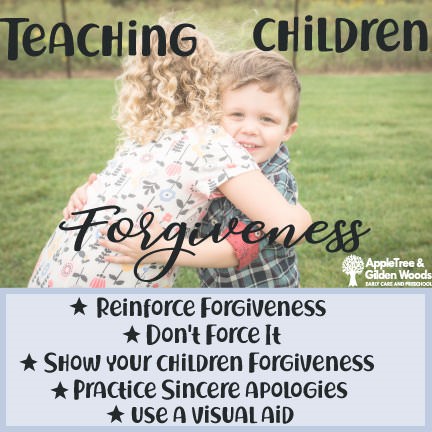- 855.520.6712
- Schedule a Tour
Forgiveness is a characteristic that shapes who we are as people. It is the groundwork for a well-balanced, happy life. Those that tend to hold grudges and have a hard time forgiving, hold on to negative energy and are molded by that.
Those that are more likely to forgive are creating more space for positivity in their life and in the world. “Let us forgive each other – only then will we live in peace.” -Tolstoy.
Below are a few ways that you can model and promote forgiveness in your life and in turn help your children learn what it means to forgive and be forgiven.

Reinforce forgiveness—We often encourage children to apologize when they have upset someone or have done something wrong. It is just as important to encourage them to forgive when they are apologized to. Enforce phrases such as, “I accept your apology”, “I forgive you”,” I’m not ready”, “thank you”, etc.
Don’t force it – We want to teach kids to be open to forgiveness, but we do not want it to become a force of habit. It is important that children are able to process their emotions and rationalize for themselves. Forcing them to accept an apology, or give one for that matter, could just be a way of giving them an out and not fully allowing them to work through it and learn the lesson it holds.
Show your children forgiveness – Children’s behavior can be trying. As they are learning boundaries, they are finding ways to test them. These explorations can quickly turn into rule breaking, aggressive behavior, or acting out. If we are gentle, understanding, and forgiving with them, then they are more likely to be understanding and gentle when needing to forgive others.
Practice sincere apologies – When you are apologizing, or asking for an apology, encourage your children to structure their apology; acknowledge the wrong doing, admit the action without excuses, and commit to learning from this mistake and letting it go to move forward.
Use a visual aid – Using a tangible learning aid helps children process the lesson more easily. Try making a forgiveness tree with your children. Draw a tree with no leaves. Each time they forgive someone, together write who they forgave and why. With time the leaves will fill the tree and make it robust and beautiful. Reflect together about how big and beautiful the tree has grown with each act of forgiveness and liken it to everyday life.
Forgiveness is not always easy, but it is an important aspect of life. Start encouraging and modeling forgiveness to your children and to all of those around you.
